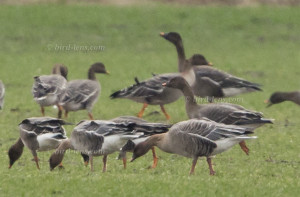 This time there was no need to patiently monitor flocks of geese with a spotting scope in windy weather and sleet and snow showers. It was cool and wet, but the Pink-footed Goose (Anser brachyrhynchus) in the Landschaftspark (landscape park) Rudow-Altglienicke could be seen quickly in flocks with Greylag Geese (Anser anser) and 2 Greater White-fronted Geese (Anser albifrons). Unfortunately, it was the way it happens often. Just when you have looked through the spotting scope and want to pick up the camera, the geese fly away quickly in several flocks. Therefore, a Pink-footed Goose from Heligoland has to serve for the blog photo.
This time there was no need to patiently monitor flocks of geese with a spotting scope in windy weather and sleet and snow showers. It was cool and wet, but the Pink-footed Goose (Anser brachyrhynchus) in the Landschaftspark (landscape park) Rudow-Altglienicke could be seen quickly in flocks with Greylag Geese (Anser anser) and 2 Greater White-fronted Geese (Anser albifrons). Unfortunately, it was the way it happens often. Just when you have looked through the spotting scope and want to pick up the camera, the geese fly away quickly in several flocks. Therefore, a Pink-footed Goose from Heligoland has to serve for the blog photo.
At the beginning of March 2023, the Rudow-Altglienicke Landscape Park attracted many bird enthusiasts and photographers, not only because of the goose but also because of a rare Dusky Thrush (Turdus eunomus). The Dusky Thrush had already been spotted on a tree in the landscape park on the outskirts of Berlin on February 7, 2023 on the adjacent site to a tree nursery not far from Berlin-Brandenburg Airport (BER). This time, of course, after the successful sighting of the Pink-footed Goose, all small bird flocks with Fieldfares (Turdus pilaris), Redwings (Turdus iliacus) and Common Starlings (Sturnus vulgaris) were meticulously searched.
It is remarkable that within 2 years a Dusky Thrush has been sighted again. At that time, Turdus eunomus was sighted in a flock of Fieldfares in the middle of the Erzgebirge near Stollberg, southwest of Chemnitz. A Dusky Thrush found on Helgoland 6 years ago was the only other recent report that could be found on the Birder website ornitho.de for Germany. Urs N. Glutz von Blotzheim describes in his “Handbuch der Vögel Mitteleuropas“ (Handbook of Birds of Central Europe), Volume 9/II “Passeriformes, Turtidae”, however, from evidence of individual sightings back to the last decades of the 19th century.
It is important to take a spotting scope with you when observing Pink-footed Geese in inland Germany. If you watch carefully, you might also see a Barnacle Goose (Branta leucopsis) or some Tundra Bean Geese (Anser fabalis fabalis). Otherwise one is dependent on reports of Pink-footed Geese in flocks with Greylag Geese, Bean Geese and Greater White-fronted Geese.
The color of the legs is mentioned in field guides as a sure sign. However, the color is not always easy to adress. A problem that occurs again and again in some observation situations – especially in backlight. The legs of the Pink-footed Geese do not look that pink compared to the orange of the legs of the Bean Geese. Once you have identified Pink-footed Geese, you can also look at other characteristics. So the mantle seems to be a bit greyer, more blue-grey, compared to the olive of Bean Geese. However, some observers noticed the brownish shimmer of the neck and head area of the Pink-footed Goose in question, here in Berlin. The beak, with its slight light (pink) portions, was also a notable contrast to the light beaks of the other two geese species.
In order to cope with the growing demand for top images of the rarer species of the Palearctic, Bird-lens.com endeavors to further expand the range of images of birds in the Western Palearctic. Trips to nearby and remote locations to snap pictures of rare birds of the Western Palearctic have been very successful. The image of the blog is just a first impression, which you can find very soon in the gallery in the “Picture Shop“. Just leave a message if bird-lens.com can serve with a picture.